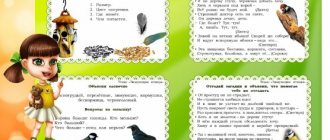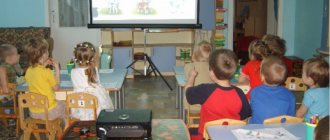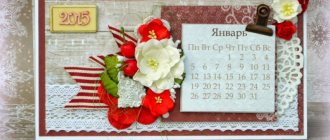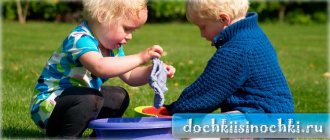Working with the nature calendar
In the middle group, it should be simple in terms of the material presented, and bright. With the help of a calendar, you can preserve in children’s memory for a long time interesting impressions from observations on the site, walks, excursions. The children's drawings reflecting what they saw are placed by the teacher on the calendar. In this case, you should select those that most accurately or figuratively represent what you saw.
The changing weather of the season also needs to be recorded. This can be done using the teaching toy “What is the weather today?”
On a thick piece of cardboard with a movable arrow fixed in the center, images of different weather conditions, but typical for a particular season, are placed or placed in transparent pockets for children's drawings. If you make the pictures interchangeable, you can use the calendar throughout the year. By combining a teaching toy with a tablet for children's drawings, already in the middle group you can create a corner for observing nature and the weather of the season. Keeping such calendars accustoms children to attention, develops the ability to observe, notice interesting and typical natural phenomena in spring, autumn, winter and summer.
In the older group of kindergarten, the nature calendar can be somewhat complicated, since children of the sixth year of life have increased the ability to perceive and comprehend natural phenomena, reflect what they see in drawings, as well as simple schematic images. Seasonal natural phenomena and weather conditions can be presented in the calendar in more detail using symbols . At the same time, the teacher should use the calendar not only as a means of recording children’s observations, but also to develop their ability to “read” the calendar.
Observation, which has increased by older preschool age, as well as the knowledge accumulated by children about weather variability, makes it possible to use a significant number (6-7) of conventional images of weather phenomena . For example, autumn weather phenomena can be represented by conventional images.
By the second half of the year, children in the older group have some basic knowledge about time (day, week). Therefore, the teacher can add a conventional image of the week (a strip with cells according to the number of days of the week) and teach children to independently note the weather conditions . Such fixed observations make it possible to show children the variability of weather, the dynamism of natural phenomena in a relatively short period of time, and also to consolidate ideas about the days of the week.
The nature calendar in the older group, as well as in the middle group, should include the most interesting drawings of children , reflecting their observations of the weather, the life of plants and animals, and people. The teacher should encourage children to make independent observations , express interest in this activity, evaluate it positively, create the need to sketch what they saw, talk about it using their drawing. Near the nature calendar it is good to have everything you need for drawing - paper, pencils or paints.
Nature calendars are designed differently in the older group. For example, at the beginning of the year, a calendar with a slight complication compared to the average group may be used. In it, plot pictures depicting various seasonal phenomena are replaced by conventional images. Images of new weather conditions are added.
In the second half of the year, children independently depict observed weather phenomena with conventional symbols and place them in the cell corresponding to the days of the week
Just like in previous groups, in the preparatory group a nature calendar is kept. It is placed in a corner of nature.
An important part of the calendar in the pre-school group is a sheet reflecting weather conditions during the month. In the cells corresponding to the days and weeks of the month, children record the weather conditions every day, using symbols for this. At the end of the month, with the help of the teacher, the number of sunny, cloudy, windy, rainy and other days is calculated and a conclusion is drawn about the prevailing weather conditions during the month.
In the second half of the year, it is recommended to note the weather conditions twice a day. To do this, each cell of the calendar is divided diagonally into two parts: morning and evening, and the weather is noted after a morning walk and before going out for an evening walk.
Forms of maintaining a calendar in a preparatory school group can be different. You can use a wall calendar .
The formation of ideas about the time of year can be carried out using a screen calendar, which has three columns: “Week”, “Weather”, “Wildlife”. The first column includes four vertical stripes indicating the days and weeks of the month. In order for children to better navigate the days of the week and learn their order, you can introduce colored images (for example, Monday - purple, Tuesday - blue, Wednesday - blue, Thursday - green, Friday - yellow, Saturday - orange and Sunday - red) .
In the second column (“Weather”), for one week (any week), the weather condition is noted daily using symbols that children can understand. Together with the children, the teacher can choose such icons and agree on what they mean. The third column contains children's drawings reflecting the state of plants, animals seen (birds, insects, animals) at a specific place in the kindergarten or in the immediate natural environment. This allows children to observe how the same place changes during a certain time of the year - spring, summer, autumn, winter - and draw a conclusion about the gradualness of the changes occurring, the increase or decrease in the effect of certain factors of inanimate nature that determine changes in living nature in season.
2. Environmental education in younger groups at different times of the year in classes and in everyday life, recording impressions.
Consultation on the topic: “Nature calendars in different age groups”
Transcript
1 Consultation on the topic: “Nature calendars in different age groups” One of the areas of children’s cognitive development is keeping nature calendars. Each kindergarten group has its own nature calendars in the nature corner. The calendar is a subject of logically structured discussion, which promotes the development of skills to reason, analyze, compare events, and then reflects them in speech (draw conclusions, generalizations), that is, it serves as a visual means of teaching logical operations and modeling activities. In the process of introducing preschoolers to nature, you can create and use a variety of models. One of them is graphical models that reflect various, long-term phenomena and events in nature. Currently, a whole system of a wide variety of calendars has been developed - flat and three-dimensional, solid and consisting of separate parts. These visual aids are multifunctional and can be considered as models of living objects or simply decorate rooms. Keeping nature calendars is of great importance for the environmental education of children from two points of view: first it is created (modeling phenomena), then it is used in the educational process. The meaning of nature calendars: children’s horizons and ideas expand, ideas about objects and phenomena of reality develop and become more precise; certain logical connections and dependencies between them are established; observation and sustainable cognitive interest develops; In terms of mental education: abstracts and clearly demonstrates the natural connection of natural objects, a relationship of a cause-and-effect nature. colorful pictures of nature at different times of the year become a means of aesthetic education; children develop an artistic perception of reality. teach preschoolers to be neat and systematic in their work. Patriotic education is also important: children learn to love and take care of their native nature, and develop a sense of pride in their land. vocabulary is enriched. When working with nature calendars, we rely on the recommendations of S. N. Nikolaeva. There are three types of calendars that are widely used in preschool institutions. Calendar for observing seasonal changes in nature. Bird watching calendar. Calendars of observations of the growth and development of living beings.
2 Calendar for observing seasonal changes in nature. The second group is of early age. In this group, nature calendars are simple. It is a picture depicting the time of year, with clearly distinguishable seasonal signs, 4 pictures depicting weather conditions typical for the season. Work with the calendar is carried out every time after observation. Returning from a walk, the children, together with the teacher, find a picture depicting the appropriate weather and put it on a stand. To clarify and consolidate emerging ideas in a corner of nature, it is necessary to have a set of color pictures of the same type in design. Familiarity with natural phenomena in early preschool age involves systematic observations in everyday life and targeted observations. It is important that children become familiar with the phenomena of each period more than once. To this end, the teacher conducts a series of observations at the beginning and end of the season and plans one week of daily observations during the high season. Junior group. In the younger group, the nature calendar takes on a more complex form: a picture depicting the 4 seasons, several pictures depicting weather conditions typical for the season. In addition to the seasons, it can contain windows or pockets, where children, after walks, insert an image of a natural phenomenon that they observed, as well as their drawings or applications on environmental topics. Children will have a desire to observe seasonal phenomena, weather changes, and mark its condition on the calendar. Middle group. The nature calendar in the middle group already consists of four blocks: 1. Picture of the season, models of the year and day. 2. A calendar with icon models (clear, cloudy, rainy, etc.) and a moving arrow pointing to them. 3. Visual and schematic model of bird observations. 4. Children’s drawings on the topic “Nature in different seasons.” With children of the middle group, it is already possible to observe two or three phenomena simultaneously. Therefore, the number of pictures can be increased by adding images of new weather conditions at different periods of the season. It is also advisable to have a set of pictures depicting a boy and a girl dressed for the season. This will help show whether it is warm or cold outside. On days when observations are not carried out, visual aids should be removed. The nature calendar in the middle group serves not only to indicate the time of year, but also the weather conditions on the current day. Design it in the form of several circles with a moving arrow, on which certain phenomena are indicated.
3 observations of both living and inanimate nature, and children, after observing and discussing the state of the weather, point with an arrow to the required picture. So S. Nikolaeva recommends that already in the middle group we begin to introduce children to symbols and teach them to use them when filling out nature calendars. But this depends on the development of the children in the group, their abilities and the work of the teacher in this direction. The calendar of observations of weather and living objects in the middle group can be calculated for a week. The required number of small images of clouds, sun, raindrops, snowflakes is prepared in advance. This material can be stored in a special pocket on the weather calendar. Weather observations can be recorded on a strip of paper drawn into five squares (according to the number of working days of the week). The windows are counted on the left. Children do not note the weather that happened over the weekend, since it is difficult for them to remember it in two days. Each day from Monday to Friday is designated by a certain color (preferably the colors of the spectrum from red to blue). The number is not announced to children in the middle group, but the days of the week are named. After observing the weather and noting its features, upon returning to the group before lunch or in the afternoon, the teacher invites the children to remember what the weather is like today and what icon it is indicated by. Children find the desired designation in the pocket and place it in the window of the corresponding color. These actions can be accompanied by explanations, first by the teacher, and then by the children themselves: “Today is Tuesday, the second day of the week, the weather is good, the sun is shining, so you need to stick a picture with the sun in the second window.” At the end of the week, the teacher, together with the children, examines images of weather phenomena, analyzes which days there were more: rainy, sunny, cloudy. The calendar can combine observation of living and inanimate nature. To do this, a sheet of paper is drawn into two stripes of five squares, in the upper one they note what the weather was like, and in the lower one, a living object of observation. In this case, the teacher must prepare a sufficient number of simplified images (flower, bird, bug, grass). If purposeful observation of wildlife during a walk was not planned, you can paste in an image based on episodic observations of children. To do this, they conduct a conversation: “What interesting, beautiful things did we see on our walk?” During the conversation, they find out what kind of object they came across (a leaf, ants, grass) and after the discussion, paste in a picture. Senior and preparatory groups. The nature calendar for older preschoolers is the most complex in content and method of recording observations and includes many different items: weather, date, month and day of the week, wildlife. Consists of several blocks:
4 1. Picture of the season. 2. Weather calendar with icon models (indication of weather phenomena using 6-7 conventional images); determination of time (day, day of the week, month, season). 3. Field “Wildlife”, to display the state of living nature: plants, land cover, animals. 4. Visually - a schematic model of bird observations. 5. Diaries of observations of plant growth and development. 6. Children’s drawings or albums on the topic “Nature in different seasons.” Filling out a calendar of observations of weather and seasonal changes, i.e. The modeling itself is carried out using icons and drawings in full accordance with observations. Every day, after a walk during which the children observed nature, they, under the guidance of the teacher, depict the weather with icons. To develop the ability to fill out a calendar, that is, to record the results of one’s observations, as well as the ability to read it (talk about observations on the calendar), it is important that the symbols are simple and understandable to children. The most appropriate designations may be the following: days of the week - in different colors (for example, Monday - purple, Tuesday - blue, Wednesday - blue, Thursday - green, Friday - yellow, Saturday - orange, Sunday - red); weather - naturalistic icons (for example, wind - a tree leaning to the side, snow - a graphic image of snowflakes, etc.). In the preparatory group, weather recording is carried out in the morning and evening. Particular attention should be paid to the designation of the degree of heat and cold: in the older group, this is a schematic figure of a child, dressed differently. In the preparatory group, it is recommended to indicate the temperature with a figurine of a man of different colors: red in hot weather, yellow in warm weather, green in cool weather and blue in cold weather. Nature calendars are complemented by albums with children's drawings. A photo exhibition can be organized about the most interesting observations. In addition to the general calendar, other forms of work to consolidate knowledge about nature can be introduced in the senior and preparatory groups: seasonal individual diaries of nature observations. Their design and management largely depends on the creative potential and desire of the teacher to instill observation skills in children. Such work is carried out in the evening, during the time allotted for free activity, with children who have expressed a desire. The teacher should help children who are interested in this type of work: draw out a landscape sheet as the child wants, sign it, help with filling it out. Individual observation calendars can be stored in a corner of nature in a folder with files and given to children in their free time. The desire of preschoolers to keep a calendar independently indicates high self-organization and developed cognitive abilities.
5 Bird watching calendar. This calendar, like others, is a model: for younger and middle ages, for older groups. The bird watching calendar is kept in winter. The calendar for primary and secondary preschoolers is filled with cards with images of birds flying to the feeder. Observations in this way are made anew every day, and no marks (“traces”) are made. Younger preschoolers, working with such a calendar, get their first impressions of the species differences of birds: by looking for cards with pictures of birds (with the help of a teacher), children have the opportunity to compare pictures with images obtained during observations. The calendar of the senior and preparatory groups is filled out differently: every day, colored marks are placed in the stripes of the corresponding day - “checkmarks” (a symbolic image of birds that remain in the calendars as traces of observations). Calendars differ not only in the recording of observations, but also in their content. The volume of simulated content for older preschoolers is much larger: a time parameter is introduced (days of the week), various features of bird behavior are recorded (who is waiting for food, who eats on the feeder and who is under it, who flies over the site and watches the birds' dinner). In the preparatory group, the composition of the feed can be recorded. Calendars of observations of the growth and development of living beings. Such calendars are kept in the senior and preparatory groups. By carrying out such work, you can observe the growth and development of plants. Let's look at the example of growing radishes. The first columns are filled in daily: the days of the week are painted in different colors, the weather and garden work are noted using icons. In the last column, a color image of the observed object is given once a week. The measuring strip is painted over the height of the plant.
6 Such observations and recordings are carried out over several weeks. They reflect the spatio-temporal parameters of the growth and development of the object of observation. One-time weekly observations and marks (color drawing) create pictures of consistent changes in the underground and above-ground parts of the object. Show how many weeks the plant's development lasts. Simultaneous recording of the weather provides insight into the conditions in which the plant develops. The observation calendar pages are combined into a screen. In this way, the consistent growth of the object of observation can be traced. In a similar way, you can model the process of growth and development of any plant (ground or indoor), grown vegetatively or from seeds, but having relatively rapid growth and a short period of development. Conclusion. The experience of introducing calendars into the practice of kindergartens has shown that the use of this type of modeling has an intense impact on the development of visual-figurative thinking. Working with the calendar at all stages (filling out, summing up, repeated examinations, comparing similar phenomena) enriches children’s specific ideas, forms a special type of ideas that reflects the process of changing natural objects in unity with the time parameter. The model thus serves as a means of developing unified spatiotemporal concepts. In addition, when discussing the results of observations, children are forced to compare the phenomena recorded on the pages of the calendar, trace the nature of changes, the relationship of individual components; Thus, they learn to detect temporary and causal relationships and establish the simplest patterns. Thus, logical thinking develops, and with it, speech inextricably develops.





